Frequency response measurement software
OS-4100
New
(Servo Analyzer/Frequency Characteristics Analyzer)
PC based Frequency Characteristics Analyzer
Achieves high-speed, high-precision frequency response measurement
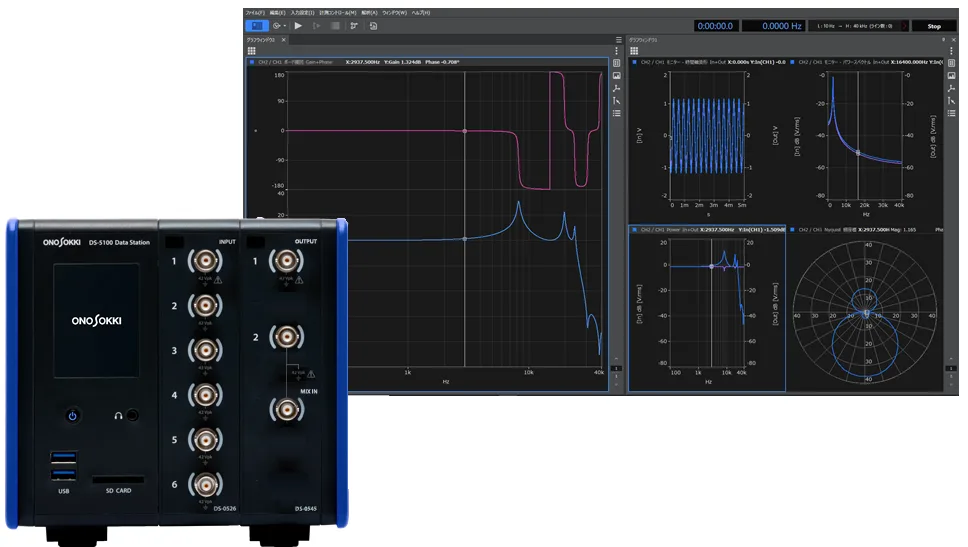
The OS-4100 is dedicated software that can measure the frequency characteristic of various objects with high precision and high speed, such as vibration characteristics of mechanical structures, acoustic characteristics of speakers, motor control characteristics, servo analysis, coupling response characteristics, and battery impedance characteristics.
This system can be used as a servo analyzer and frequency characteristic analyzer and obtain frequency characteristic easily, quickly, and with high resolution.
Overview
Software
This software is equipped with new functions such as automatic measurement and step response functions on top of all the functions of the existing models.

Hardware
The DS-5000 series is more compact than the existing model DS-3000 and has improved dynamic range.
All channels are isolated, and it is resistant to noise.
Dynamic range: 110 dB → 130 dB
Max. number of measurable channel: 32 ch → 42 ch
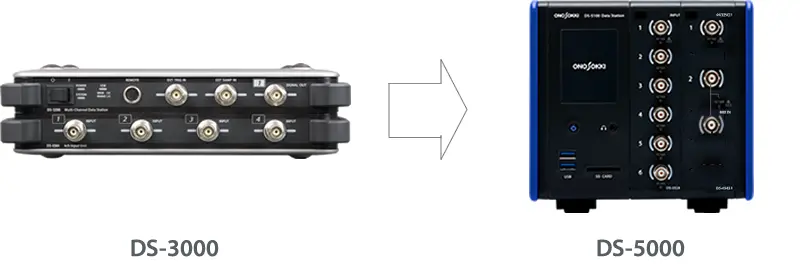
Features
1. Measure wide frequency band with speedy and high resolution
Two types of calculation methods are equipped.
Equipped with two types of calculation methods, you can select according to the measurement scene and purpose.
Obtains gain and phase for each signal frequency.
This method is used for high accuracy and high dynamic range measurement.
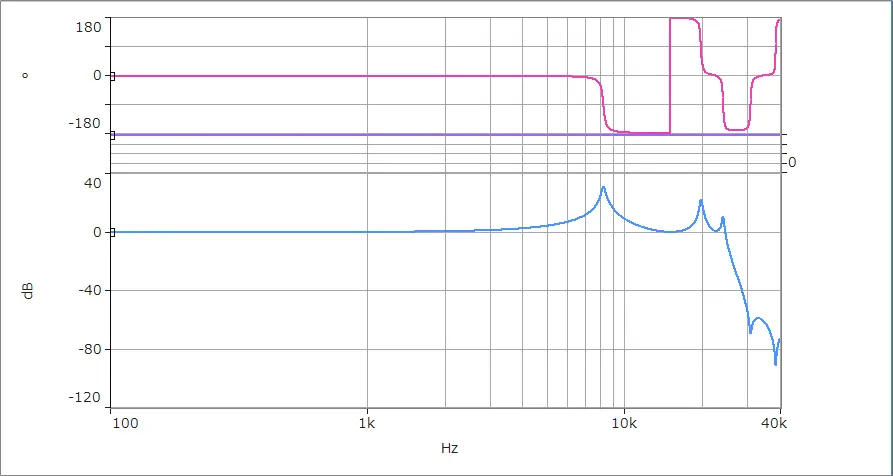 Signal output: Log sine sweep
Signal output: Log sine sweepFrequency resolution: 200 Lines/Decade (10 Hz to 40 kHz)
Measurement time: 78 seconds (Averaging count 2 times/Line)
Obtains gain and phase over a wide frequency range at high speed.
This method can quickly grasp the frequency characteristics.
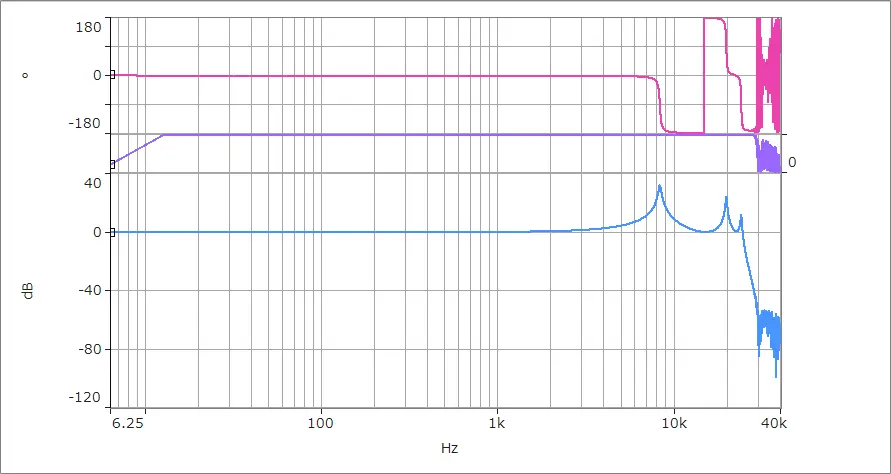 Signal output: Random
Signal output: RandomFrequency resolution: 6.25 Hz (6400 Lines)
Measurement time: 17 seconds (Averaging count 100 times)
Significant reduction in calculation time of FRA method
Reviewing the existing calculation method and realizing a great reduction in measurement time
Example
| Measurement condition 1 | Measurement condition 2 | |
|---|---|---|
| OS-4100 | 54 sec | 100 sec |
| DS-0342 | 195 sec | 365 sec |
Condition 1: FRA method 1 Hz to 1,000 Hz 50 Line/Decade
Condition 2: FRA method 1 Hz to 100 Hz 100 Line/Decade
2. Highly flexible and various graph displays
Frequency response function (FRF) such as Bode graph, Nyquist graph, Co-quad graph, Nichols graph, Cole-Cole plot can be displayed in various ways.
The time waveform and its instantaneous spectrum while measurement can be monitored, and the connection method or abnormality of data can be checked in real-time.
You can change the display position of each window freely with the docking window.
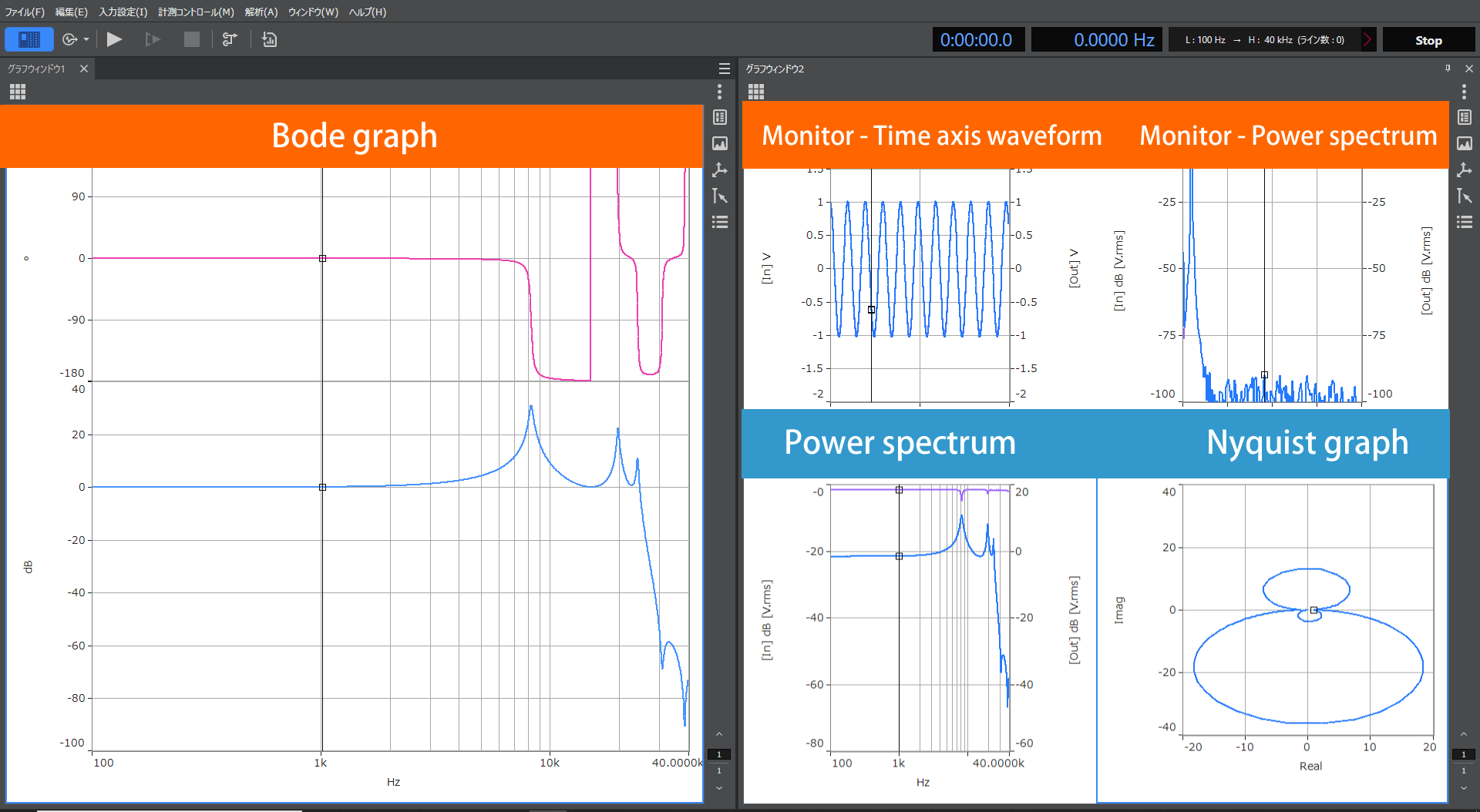
You can monitor the time waveform and power spectrum of each channel while measuring the frequency response function.
There is no need to prepare an oscilloscope for monitoring.

3. Achieves the measurement of machine control characteristics and noise/vibration with one hardware
Control characteristics measurement (OS-4100) and noise/vibration measurement (O-Solution) can be measured with one hardware. By using different software according to the application, it can be used for various measurements at an affordable cost.
In the case of a camera, measure image stabilization control with the OS-4100 and its motor noise with the O-Solution.

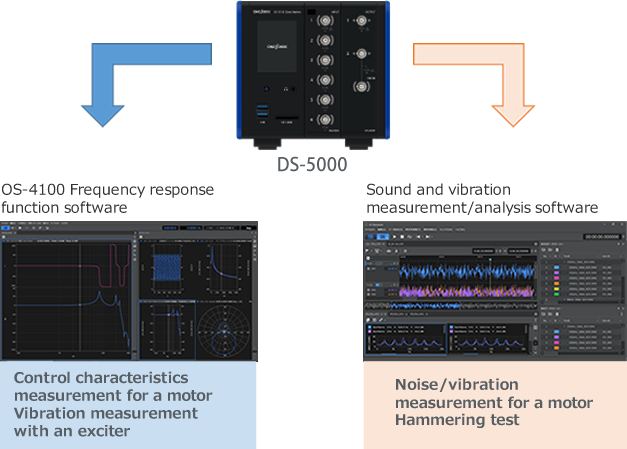
Functions
It has the useful functions for various application.
Listing up peak points and damping factor, auto search of gain margin and phase margin.
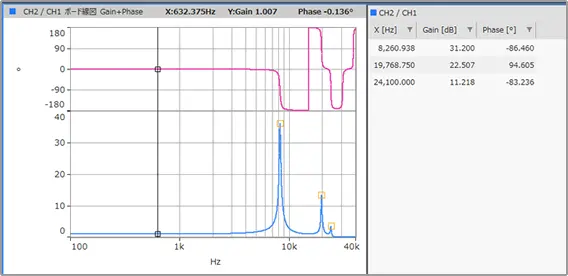
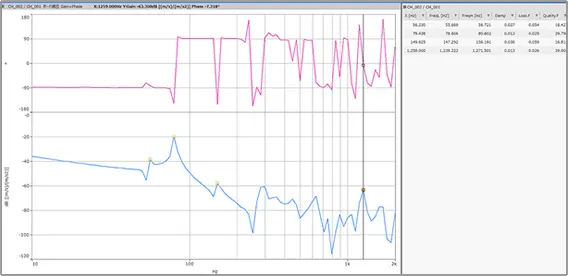
This function enables to remeasure the frequency response function to partially increase the frequency resolution.
After capturing the overall frequency characteristics, if there is an area (such as a resonance position) that you want to measure with high frequency resolution,
you can remeasure only that area with high frequency resolution. This helps to reduce measurement time.
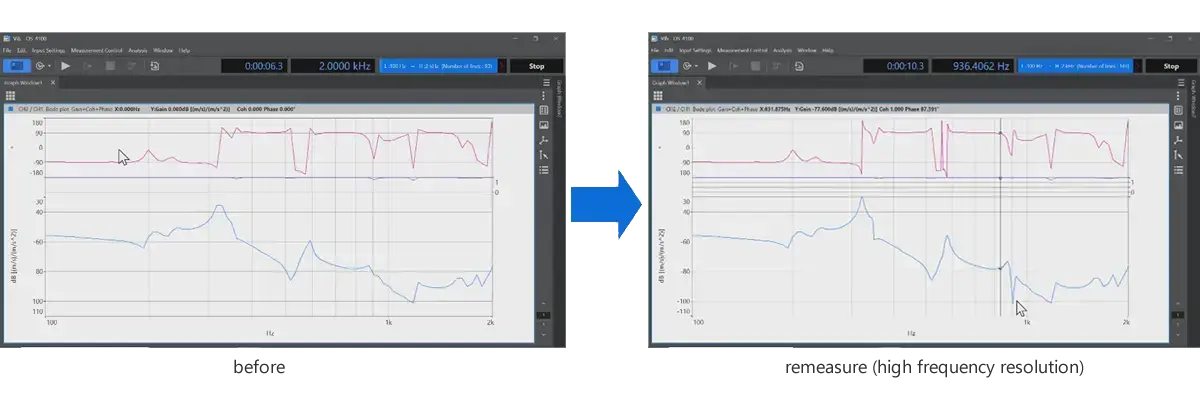
The OS-4100 can import the data acquired by the DS-3000 series, the DS-0342 (servo analysis) and the O-Solution. It also can compare with the past data or the frequency response function obtained in the hammering test.
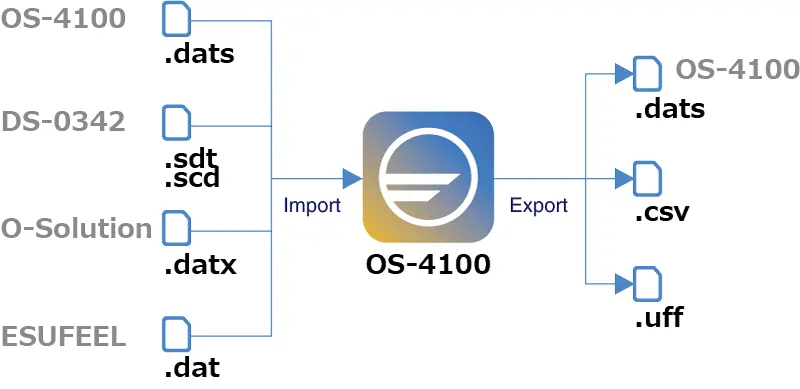
Evaluating the vibration damping properties of materials
It allows to calculate the loss factor and Young's modulus of a damping material from the frequency response function obtained by the OS-4100.
It has the External control function as an option which can communicate with the user's application via TCP/IP, measure under measurement conditions prepared in advance and save.
Automated inspection process for mass-production
Automate each operation such as setting, measuring and saving with one button.
Control measurement instruments from other apps
Control the measurement start/end timing and specify the measurement conditions.
| OS-0410 External control (Option) | |
|---|---|
| LAN port | For control side and communication (No required when operating within a PC) |
| Protocol | TCP/IP |
| Character code | ASCII |
| Line feed code | CR+LF |

System configuration
It consists of the DS-5000 series (FFT analyzer) and a PC.
The signal output from the DS-5000 series (FFT analyzer) is input to the measured object. Measure the input signal and output.

Application examples
Motors and drivers incorporated in various products such as robots, conveyance equipment, semiconductor manufacturing machines, and automobiles have control circuits built in to control their rotational speed and torque. As the stability evaluation of control characteristic, there are gain margin and phase margin measurements.The OS-4100 can automatically calculate gain margin and phase margin from frequency response function (open loop transfer function).
It can obtain the open loop transfer function by measuring the closed loop transfer function. The DS-0545 2ch Signal Output Unit outputs the signal that the signal generated from the DS is added to the feedback signal from the object, which makes it possible to directly input signals to the control circuit and easily evaluate the stability of the control circuit. In addition, by using the step response function it measures and automatically calculates responsiveness (delay time, overshoot value, etc.) in the time domain.
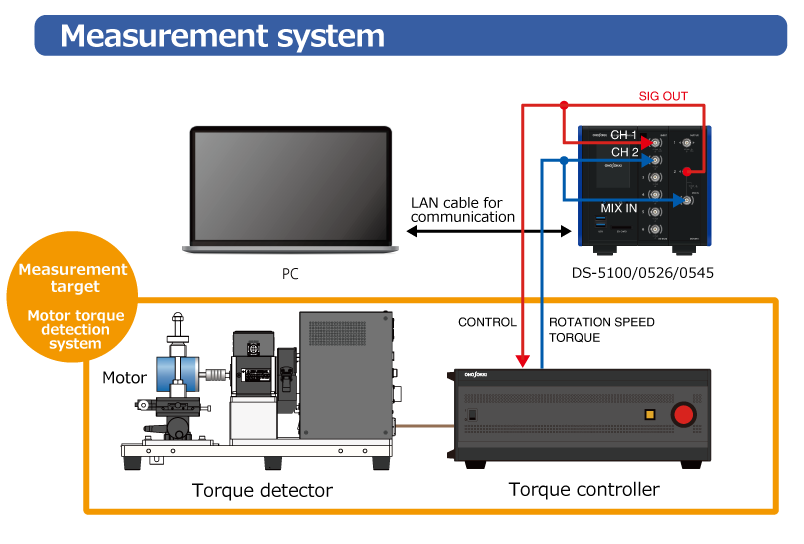
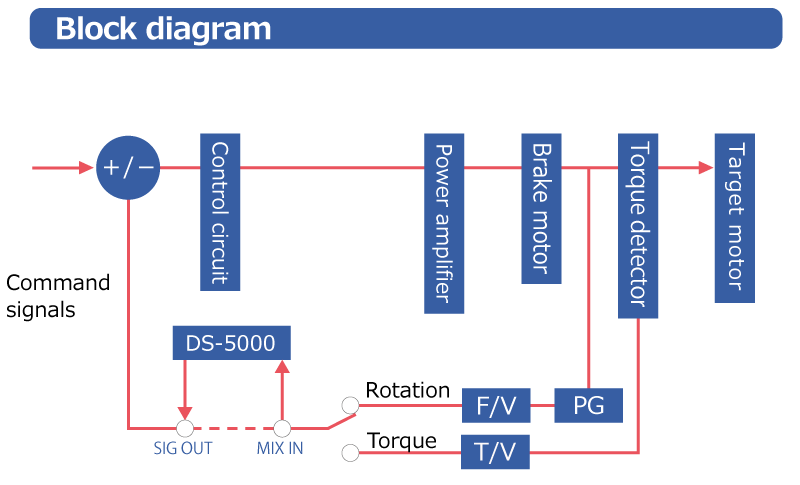
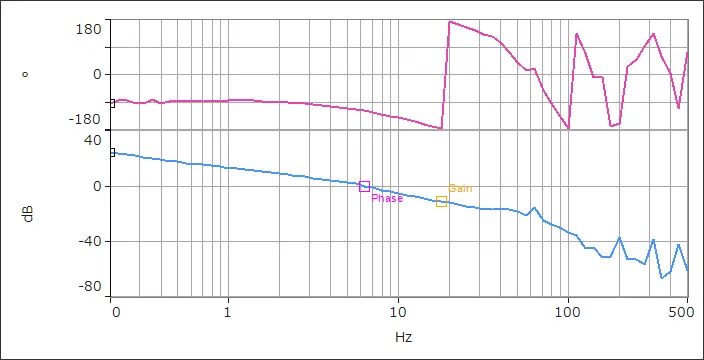
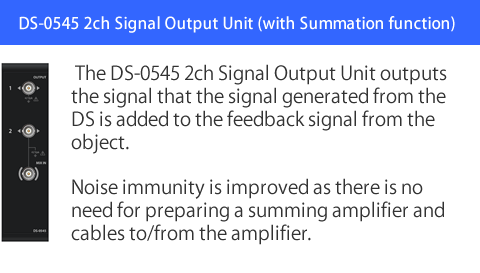
The performance of the object can be obtained from the temporal response. By applying step signals to the object and measuring the step response signals, it automatically calculates the values related to response performance (rising time, etc.) and compares actual measurement data with past data.
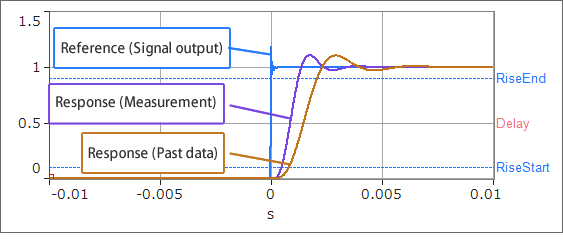
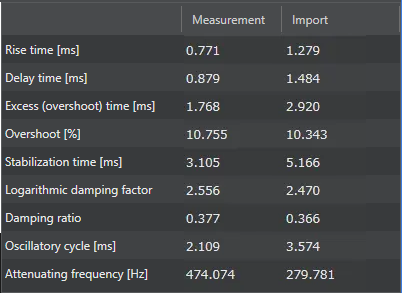
(Cooperation: Citizen Chiba Precision Co., Ltd.)
The Galvanoscanner is equipped with a motor to adjust the scanning angle of the mirror that reflects the laser beam and a high-precision position sensor. It is used in a wide range of applications in combination with laser beam, such as laser markers, microscopes, and LiDAR, and is required to scan mirrors over a wide range at high speed and with high precision. When developing products, it is necessary to perform highly accurate simulations to achieve high speeds and optimize models and control parameters. In addition, in order for customers to use products with peace of mind, it is required to confirm that the product's performance is guaranteed before shipping. Therefore, it was a challenge to easily measure and understand the control characteristics of the Galvanoscanner and the mirror's resonant frequency with high precision.
2-1. Evaluation of galvanoscanner control characteristics
Results of comparing three types of control parameters
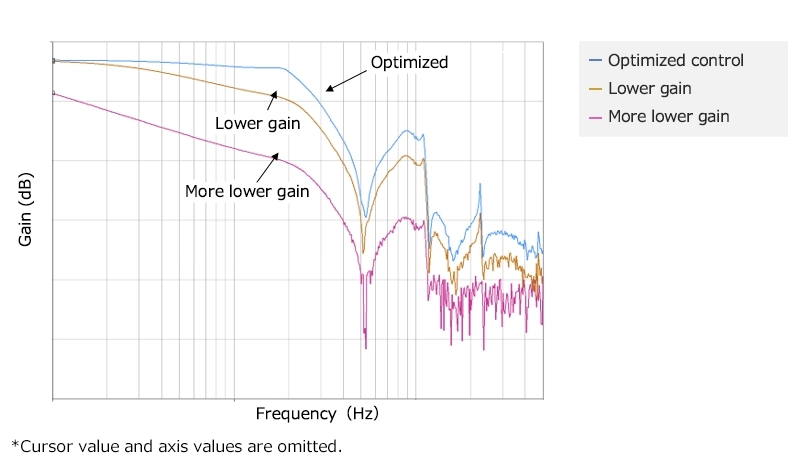
2-2. Measurement of mirror resonance
Comparison of three types of mirrors
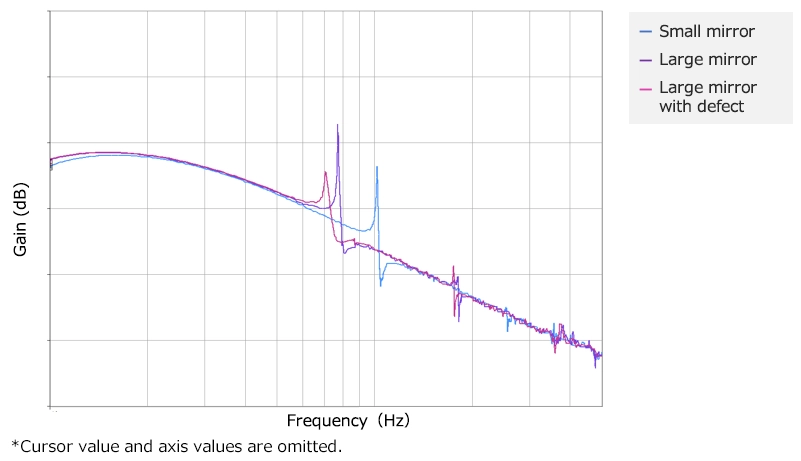
Please see the related pages below.
Application example: Evaluation of galvanoscanner control characteristics
Customer Reviews: Application example in control characteristic evaluation
When vibration is applied to a structure, if that vibration frequency is equal or close to the structure's natural frequency, resonance will occur, resulting in extremely large vibrations that may lead to failure or destruction. Therefore, it is important to evaluate the vibration characteristics of structures. The OS-4100 can simultaneously measure up to 42 channels of vibration characteristics using an exciter.
It can convert acceleration to displacement by the calculus function, control the amplitude value of excitation by the amplitude control function, and measure the characteristics after subtracting the weight of the jig (mass cancellation) by the four arithmetic operations (Calculation between items).
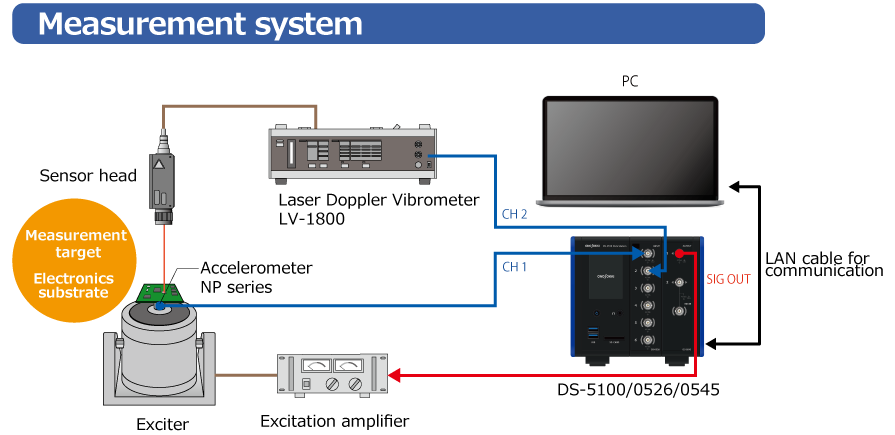
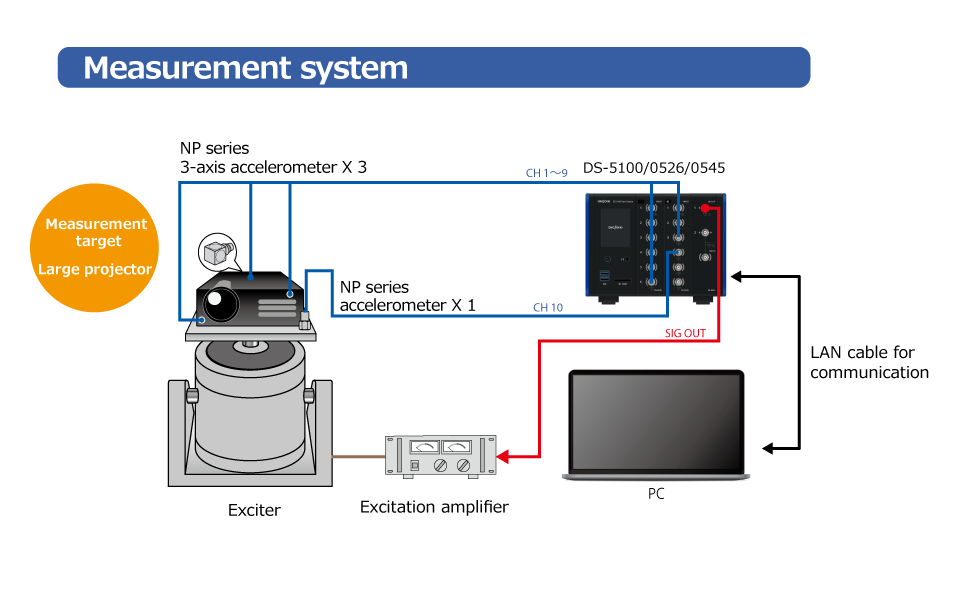
Image of measurement results
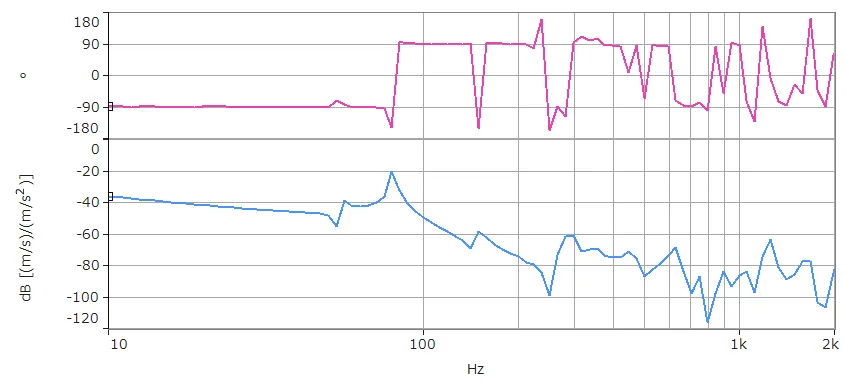
The amplitude of the exciter can be controlled. The amplitude of the signal output (DS-5000) can be automatically adjusted so that the measured amplitude becomes the preset amplitude. Vibration characteristics can be measured without being affected by jig vibration characteristics. In addition, the amplitude (displacement) can be controlled with an accelerometer.
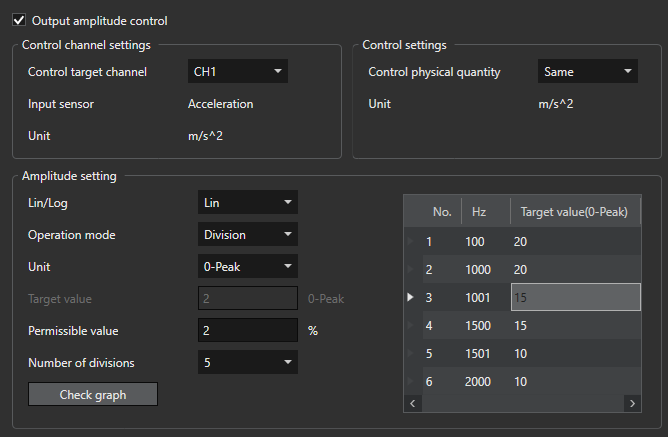
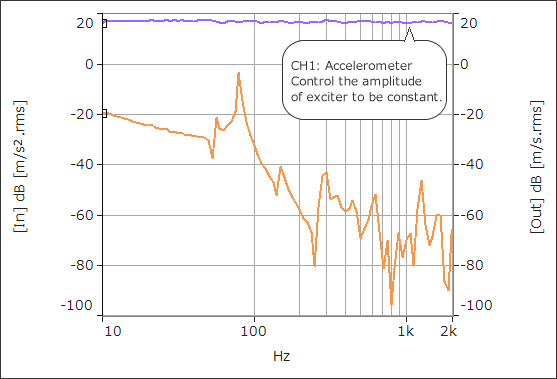
One of method for evaluating batteries is the AC impedance method. This method enables to evaluate battery resistance characteristics (deterioration of electrodes, etc.) without destroying or disassembling the battery. The AC impedance can be measured by applying an AC current load to the battery and measuring the voltage and current of the battery.
By adopting the FRA method, it is possible to measure with high accuracy and high frequency resolution in a wide dynamic range. It can display with a Cole-Cole plot, which is useful for estimating the cause of battery deterioration. uff file or HDF5 format is available for easy transfer of measurement results to simulation software.
* An electronic load device and a current probe are required for this measurement.
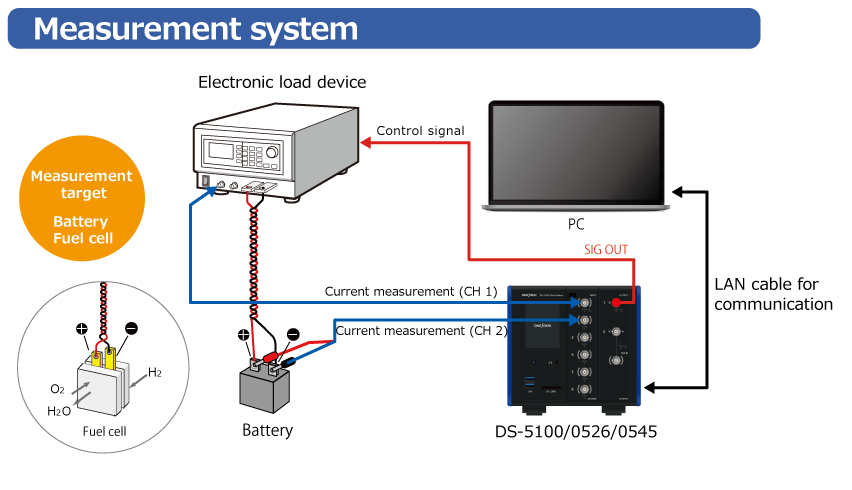
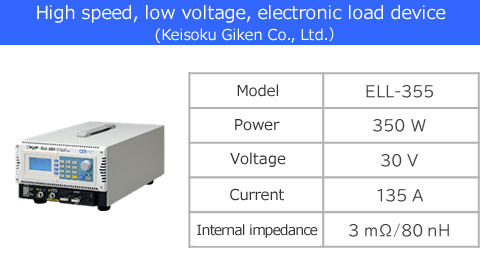
Image of measurement results
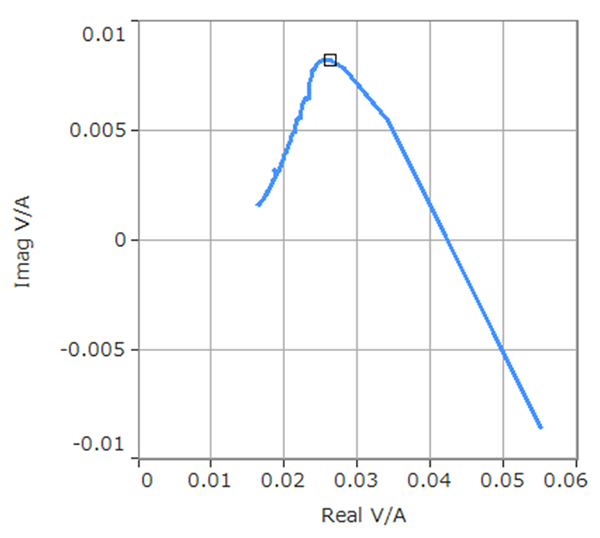
A Cole-Cole plot is a graph that shows the real part of the frequency response function on the horizontal axis and the imaginary part on the vertical axis.
It is useful to examine an equivalent circuit.
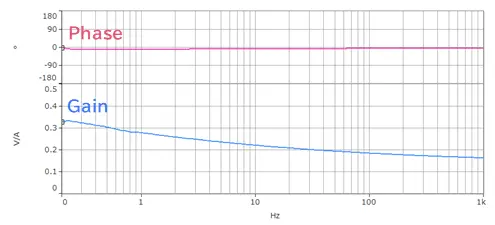
The setting can be changed for each frequency to be measured. It can shorten the measurement time to measure only important frequency bands with high frequency resolution or measure bands with few variation roughly. In addition, by changing the amplitude of the signal output for each frequency band, optimal measurement can be performed to improve S/N.
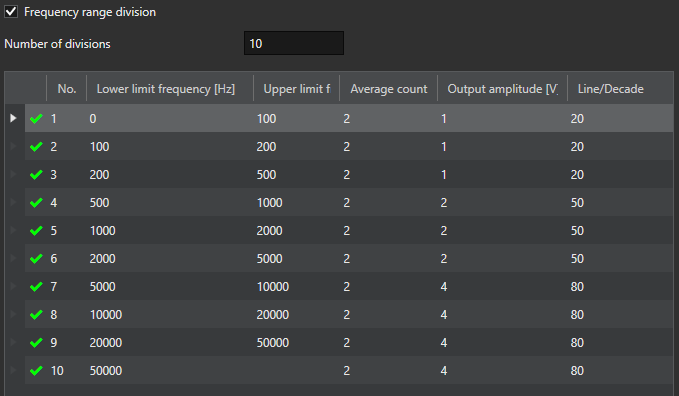
Sound frequency characteristics is one of the factors that evaluate speaker performance. By connecting the signal output from the DS-5000 to the speaker amplifier and capturing the sound generated from the speaker with a sound level meter or microphone, the OS-4100 measures the frequency characteristics of the speaker. Also, the function (cutoff search function) which finds a cutoff frequency automatically is equipped.
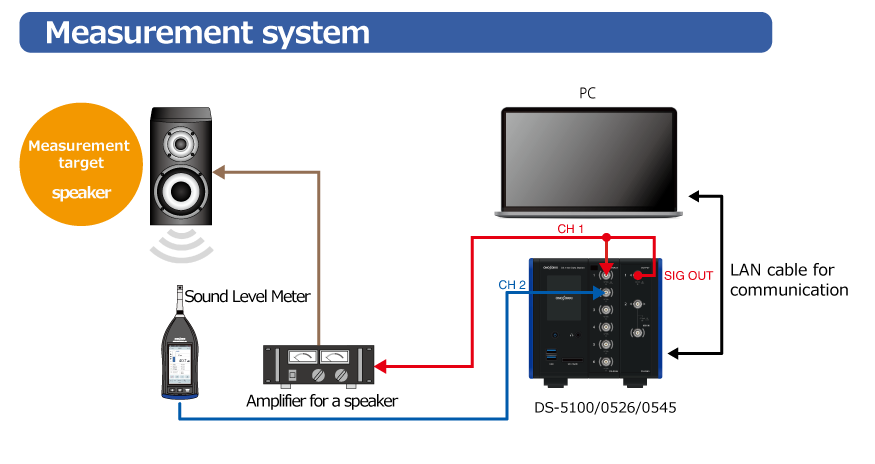
Image of measurement results
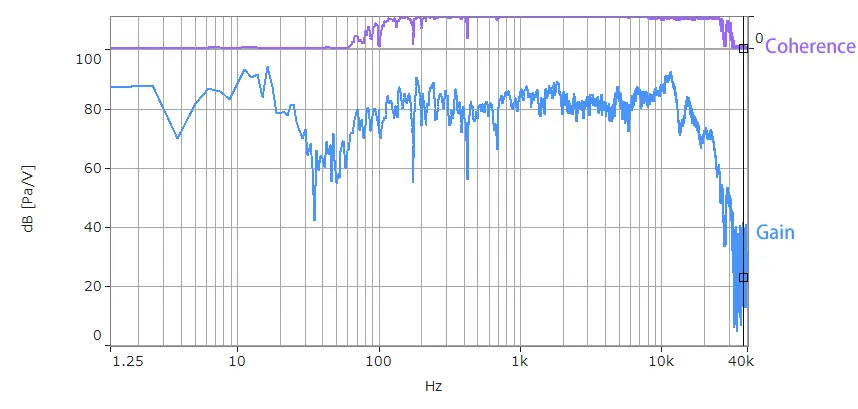
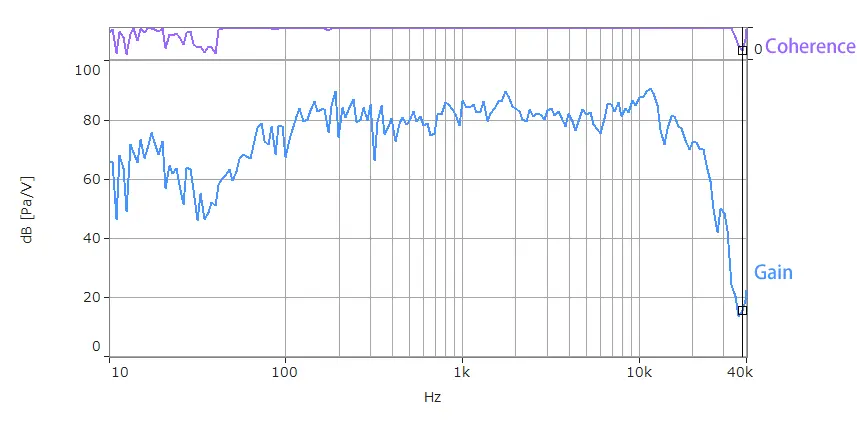
When evaluating the characteristics of electrical systems such as filters and amplifiers, the OS-4100 enables to measure frequency characteristics with high resolution. It also has a function to automatically search for a frequency to cutoff.
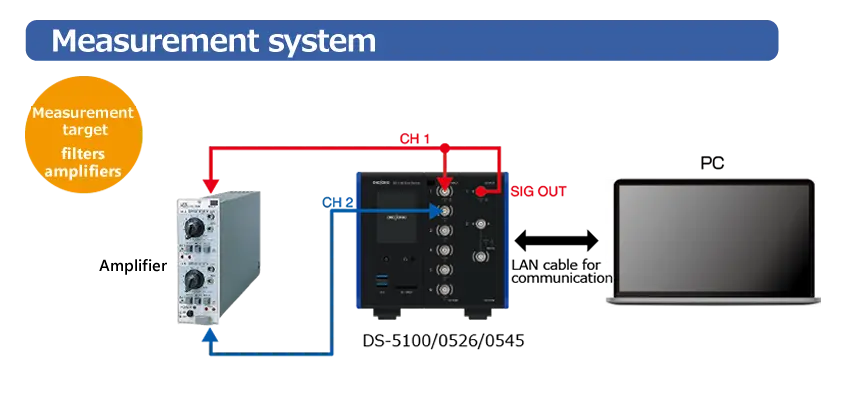
Specification
| Input section | |
|---|---|
| Number of measurement channels | 40 kHz unit- 3 to 42 ch (DS-0523, DS-0526) 100 kHz unit- 2 to 4 ch (DS-0532, DS-0534) |
| Hardware to Hardware connection | Nil |
| Input voltage range | -30 / 0 / +30 dBVrms (3 types) |
| Power supply for sensor | +23 V to 26 V / 4 mA±25 % (25 ℃) |
| TEDS function | ・IEEE 1451.4 Ver.0.9/1.0 accelerometers, microphones ・IEEE 1451.4 Ver.1.0 force sensors |
| A/D converter | 24 BitΔΣ type |
| Coupling | AC/DC with automatic switching function |
| Terminal | BNC (Voltage input/ CCLD switchable) |
| Voltage auto range function | It is possible to measure while optimally selecting the voltage range of each channel according to the level of the input signal automatically. |
| Phase accuracy between channels | ±0.1° (less than 20 kHz), ±0.7° (20 kHz or more) |
| Dynamic range | 160 dB (FRA mode: 40 kHz/100 kHz unit) 130 dB (FFT mode: 40 kHz unit) 120 dB (FFT mode: 100 kHz unit) |
| Isolation | 42.4 Vpk (between BNC ground and hardware/between each BNC ground) |
| Signal output section | |
|---|---|
| Number of output channels | 1ch (DS-0543 or DS-0545) Compatible with 40kHz and 100kHz |
| Type of output signal | Sine/ Sine sweep (log/ Linear)/ Swept sine/ Random/ Pseudo-random/ Impulse |
| Output voltage | Max. ±10 V (Peak) including offset voltage and amplitude |
| D/A converter | 24 BitΔΣ type |
| Max. output current | 10 mA |
| Output taper | Upward and downward taper (1 ms to 10 s) |
| Measurement start delay | Set delay time from signal output until measurement (1 ms to 10 s) |
| Offset output | Max. ±10 V (Peak) including the amplitude of output voltage. Capable of always outputting offset voltage. |
| Isolation | 42.4 Vpk (between BNC ground and hardware/between each BNC ground) |
| Addition function | Installed in DS-0545 2ch Signal output unit. It can output the signal, which is the sum of the signal input to DS-0545 and the output signal generated by the main unit. It is also possible to output the addtion signal and the signal generated by the DS-0545 at the same time. |
| Calculation section | |
|---|---|
| FRA mode (Sine sweep) | |
| Measurement frequency range | 40kHz unit: 10 mHz to 40 kHz 100kHz unit: 10 mHz to 100 kHz |
| Frequency resolution | Log: line/Decade 2 to 2000 (4000) Liner: line/Total 200 to 25000 (5000) |
| Frequency range division setting | Measurement can be made by dividing the measurement frequency range up to 30, changing the number of additions, output signal amplitude and frequency resolution. |
| Auto resolution control function | The function automatically optimizes the frequency resolution so that the characteristics of the entire frequency range can be observed with high accuracy. |
| Output amplitude control function | [Amp.Control ch] Select from options. [Control physical quantity] Select Control setting Lin or Log. For acceleration, speed and displacement, calculus is performed and can be controlled by another physical quantity. [Control mode] Set constant or division (number of division up to 30), unit (p-p, rms, 0-p), acceptable, initial voltage, maximum output voltage |
| FFT mode (random, swept, impulse) | |
| Measurement frequency range | 40 kHz unit: up to 40 kHz 100 kHz unit: up to 100 kHz |
| Output method | Random/ Pseudo-random/ Swept sine/ Impulse |
| Number of sampling points | Max. 65536 (25600 lines) (32768 or more: random signals only) |
| Frequency range (single range) | 10, 20, 25, 40, 50, 80, 100, 160, 200, 400, 500, 800, 1k, 1.6k, 2k, 2.5k, 4k, 5k, 8k, 10k, 20k, 40k (For 100 kHZ unit, 25k, 50k, 100k in addition to the above, excluding 1.6k, 8k) |
| Frequency range (pair range) | Hi : same as a single range Low : 1/5, 1/10, 1/20, 1/50, 1/100 of Hi range |
| Display section | |
|---|---|
| Frequency response function | Co-quad graph (horizontal axis: frequency/ vertical axis: real part and imaginary part) Bode graph (horizontal axis: frequency/ vertical axis: gain and phase) Nyquist graph (horizontal axis: real part/ vertical axis: imaginary part) (Logarithmic axis display of amplitude is available) Nicols graph(horizontal axis: phase/ vertical axis: gain) Cole-cole plot (horizontal axis: real part/ vertical axis: imaginary part) |
| Monitoring | Time waveform/ power spectrum |
| List | Peak point (auto search of amplitude peak value) Arbitrary point Gain margin/phase margin (auto search) Damping ratio (loss factor) |
| Auto search of cutoff fequency | Available |
| Step response | |||||||
|---|---|---|---|---|---|---|---|
| Auto calculation values | Rising time, delay time, excess time, overshoot, oscillatory cycle, stabilization time, damping ratio, logarithmic damping factor, attenuating frequency | ||||||
| Output signal (step signal input to target object) |
When input impedance: 1 MΩ, input capacity: 1 μF output voltage of DS-5000 at 1 Vp-p
| ||||||
| File format | |
|---|---|
| Import file format | DATS (OS-4100) DATX (O-Solution) SDT/SCD (DS-0342) DAT (DS-3000) CSV (export from OS-4100) |
| Export file format | DATS (Type HTF5) CSV UFF |
*The OS-4100 enables to obtain measurement data by combining with the DS-5000 (hardware).
For details of the DS-5000, please click here.
| [Overview Specification] OS-0410 External control | |
|---|---|
| Protocol | TCP/IP |
| port | arbitrary |
| Character encoding | ASCII |
| Newline code | CR+LF |
| C (Client) / S (Server) | S (Server) |
| [Operating Environment] | |
|---|---|
| Interface | LAN terminal 1000base-T |
| OS | Microsoft® Windows® 10 Pro (64 bit) Microsoft® Windows® 11 Pro (64 bit) Microsoft® Windows® 11 Enterprise LTSC (64 bit)* |
| Applicable .NET Framework | .NET Core 6.0 Desktop Runtime |
*Windows 11 Enterprise has been tested and verified to operate correctly in environments using the default configuration (including standard policy settings). We do not guarantee compatibility in environments where default settings have been modified—such as changes to security configurations, group policies, or the use of third-party security software. As a result, support for operation in such customized environments may be limited.
| [Recommended specifications ] | |
|---|---|
| CPU | Intel® CoreTM i7 8th Generation or later generation, 4 cores and 8 threads or more, and 1.8 GHz or more base clock frequency |
| Memory | 16 GB or more |
Related information
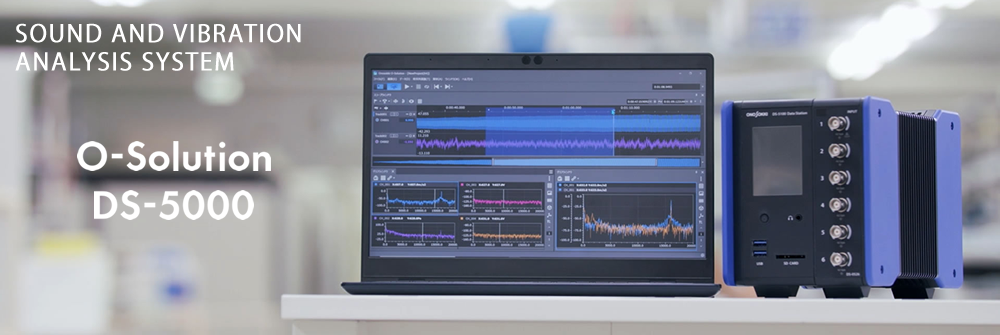
Revised:2025/10/20
